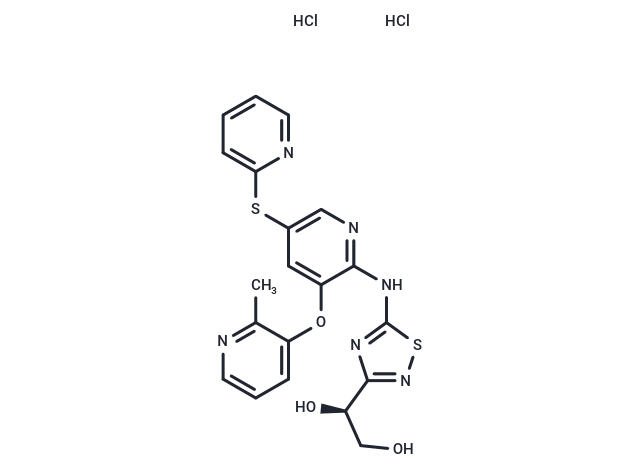 您的购物车当前为空
您的购物车当前为空
AMG151 HCl
一键复制产品信息ARRY-403, also known as AMG-151, is an orally available allosteric glucokinase (GK) activator developed for the treatment of type 2 diabetes mellitus (T2DM). ARRY-403 has many favorable physicochemical characteristics and ADME properties (low potential to cause drug–drug interactions (DDIs). ARRY-403 potently activates human glucokinase (GK) in vitro (EC50 = 79 nM at 5 mM glucose), with an S0.5 = 0.93 mM glucose (ARRY-403 at 5 mM) and Vmax = 134% compared to the no activator control. It possesses good in vitro drug-like properties (aqueous solubility, cell permeability, low low potential for drug-drug interactions, low predicted hepatic clearance), and selectivity against broad panels of receptors and enzymes.

AMG151 HCl
一键复制产品信息ARRY-403, also known as AMG-151, is an orally available allosteric glucokinase (GK) activator developed for the treatment of type 2 diabetes mellitus (T2DM). ARRY-403 has many favorable physicochemical characteristics and ADME properties (low potential to cause drug–drug interactions (DDIs). ARRY-403 potently activates human glucokinase (GK) in vitro (EC50 = 79 nM at 5 mM glucose), with an S0.5 = 0.93 mM glucose (ARRY-403 at 5 mM) and Vmax = 134% compared to the no activator control. It possesses good in vitro drug-like properties (aqueous solubility, cell permeability, low low potential for drug-drug interactions, low predicted hepatic clearance), and selectivity against broad panels of receptors and enzymes.
| 规格 | 价格 | 库存 | 数量 |
|---|---|---|---|
| 25 mg | ¥ 15,000 | 8-10周 | |
| 50 mg | ¥ 19,800 | 8-10周 | |
| 100 mg | ¥ 25,500 | 8-10周 |
AMG151 HCl 相关产品
产品介绍
| 产品描述 | ARRY-403, also known as AMG-151, is an orally available allosteric glucokinase (GK) activator developed for the treatment of type 2 diabetes mellitus (T2DM). ARRY-403 has many favorable physicochemical characteristics and ADME properties (low potential to cause drug–drug interactions (DDIs). ARRY-403 potently activates human glucokinase (GK) in vitro (EC50 = 79 nM at 5 mM glucose), with an S0.5 = 0.93 mM glucose (ARRY-403 at 5 mM) and Vmax = 134% compared to the no activator control. It possesses good in vitro drug-like properties (aqueous solubility, cell permeability, low low potential for drug-drug interactions, low predicted hepatic clearance), and selectivity against broad panels of receptors and enzymes. |
| 分子量 | 527.439 |
| 分子式 | C20H20Cl2N6O3S2 |
| CAS No. | 1609674-80-7 |
| 存储 | Powder: -20°C for 3 years | In solvent: -80°C for 1 year | Shipping with blue ice/Shipping at ambient temperature. |





 还可以
还可以

 |
|
评论内容